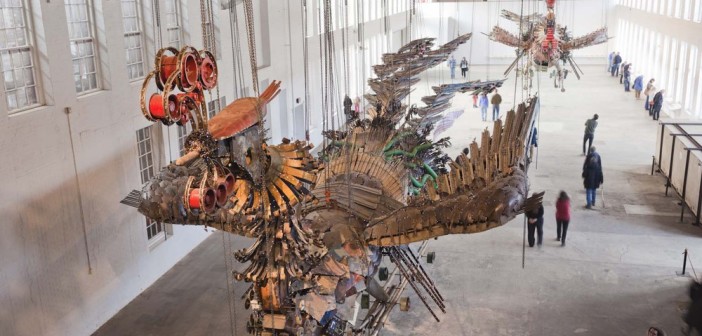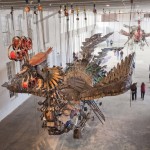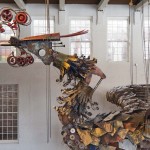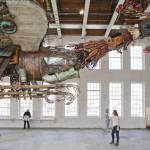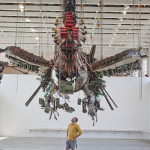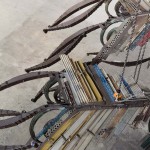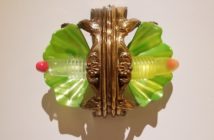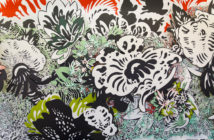Xu Bing: Phoenix, currently on exhibit at MassMoCA, is poetic and political. The artist’s beautiful installations make a traditional artistic statement at first glance. However, an unexpected use of materials gives these works deeper meaning, with insight into Xu’s personal history as well as commentary on the cost of continual economic growth in the artist’s home country of China. Issues of capitalism, labor and consumption frame the exhibition, as these works have an elegant, strong conceptual background.
Upon entering the exhibition, the viewer is confronted by Background Story 7, a seemingly conventional Chinese landscape. However, this work is actually a lightbox lit from behind to create the illusion of painting. Bristly shrubs and misty mountains are created on the front of the ‘canvas’ by taping discarded materials and natural debris to the back of translucent acrylic. Background Story 7 is a lively and respectful re-creation of a 1705 Qing Dynasty work, Landscape Painted on the Double Ninth, in the collection of the Metropolitan Museum of Art. By using common, ephemeral materials, Xu is creating not a concrete painting, but a work of shadows that play with the viewer’s perceptions.
Stowed away in the back of the exhibition is what appears to be a forty foot long tiger skin carpet, but is actually more than half a million cigarettes adhered together standing either filter or tip side up. Creating the look of animal stripes with an intricate pattern of white and orange, 1st Class is a commentary on global trade and exploitation. This work is part of a series that explores the history of the tobacco industry and trade in the various places where Xu has worked. 1st Class responds to the history of Duke University, where Xu was a visiting artist. The Duke family made their fortune in tobacco and found great success in targeting China as a new market for tobacco products. The cigarettes used in 1st Class are an American discount brand, while the cigarettes used for a similar work, Honor and Splendor, that was shown at the Shanghai Gallery of Art, are a discount Chinese brand instead. A solo exhibition at the Virginia Museum of Fine Arts surveyed the wide-ranging works Xu has created relating to the tobacco industry. Included in this exhibit was a work that calls attention to Xu’s personal connection to the topic—a recorded voice reading out the medical records of Xu’s father, who died from lung cancer. This series highlights his fascination with the past and how it informs today’s economies and politics.
The monumental work Phoenix is the centerpiece of the exhibition. This work consists of a pair of enormous birds, each 12 tons in weight and almost 100 feet long, suspended from the ceiling of the museum’s Building 5 gallery. The tremendously challenging installation of this work is a fascinating story, and one that is explained on MassMoCA’s blog. Like other works by Xu Bing, Phoenix originates with a traditional Chinese motif and is transformed through unexpected materials. Xu was originally commissioned to create the work for the glass atrium of the World Financial Tower in Beijing. Upon visiting the site, Xu was shocked by the contrast between the poor conditions of the construction workers and the fast-paced economic development of China. As a result, Xu created Phoenix with construction debris from work sites, which caused the builders of the Financial Tower to withdraw their commission. Luckily, Xu found alternative support for the project, and Phoenix has been exhibited at two art institutions in China as well as at Mass MoCA. Thus, a work that was originally intended to be a celebration of China’s economic successes now highlights the inequalities that this prosperity has created.
- Xu Bing: Phoenix | Mantle Photo courtesy of Hideo Sakata
- Xu Bing: Phoenix | Mantle Photo courtesy of Hideo Sakata
- Xu Bing: Phoenix 2 | Mantle Interior Photo courtesy of Hideo Sakata
- Xu Bing: Phoenix 2 | Mantle Interior Photo Courtesy of Julian Price Jr.
- Xu Bing: Phoenix 2 | Mantle Interior Photo Courtesy of Hideo Sakata
Xu Bing: Phoenix is on view through Oct 27, 2013 at Mass MoCA.

